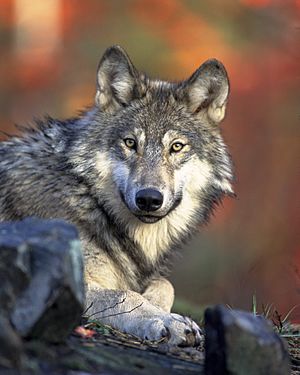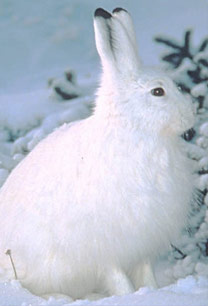Wolves and moose on Isle Royale facts for kids
Isle Royale, a remote island in Lake Superior, is home to a special relationship between wolves and moose. For over 50 years, scientists have closely watched how these two animal populations interact. Because the island is isolated, animals rarely move on or off it. Also, since it's a national park, people don't interfere much with the wolves and moose. Both species first settled on Isle Royale in the 1900s. Over the years, their numbers have gone up and down many times. Moose populations have ranged from 500 to 2,500, while wolf numbers have varied from almost 50 down to just two. In 2018, new wolves were brought to the island to help the wolf population grow again. This study is the longest of its kind, starting in 1958.
Isle Royale National Park includes about 400 islands in the northwest part of Lake Superior. It is about 50 miles (80 km) from Michigan's shore and 12 miles (19 km) from Canada. The main island is about 45 miles (72 km) long and 9 miles (14 km) wide at its widest point. It covers an area of 205 square miles (531 km²). There are no roads or motorized vehicles allowed on the island. The park closes from September to May. During this time, only the wolf-moose study team lives there.
Contents
How Wolves and Moose Interact
Isle Royale did not always have wolves or moose. Scientists believe moose swam to the island from Minnesota in the early 1900s. Some think people might have brought them for hunting. In 1949, a few wolves, perhaps just one pair, crossed an ice bridge from Ontario during a cold winter. Because only a few wolves came, they have faced serious inbreeding. This means they are all closely related, which can cause health problems. According to researcher Rolf Peterson, all the wolves' DNA on Isle Royale can be traced back to one ancestor. Inbreeding can lead to weaker animals and social problems among the wolves.
When the study began in 1958, many thought the wolf and moose numbers would balance out. They expected about 25 wolves and 1,500 moose. However, this has not happened. The populations keep changing in unexpected ways. The most moose seen was 2,450 in 1995. The most wolves seen was 50 in 1980, but their numbers quickly dropped to 14 by 1982.
What Moose Eat
The number of wolves and moose depends a lot on the amount of food available. Moose like birch and aspen trees, which used to be common on the island. But over a century of moose eating them has led to fewer of these trees. Now, moose mostly eat balsam fir, which is not as nutritious. Balsam fir makes up 59% of a moose's diet. Even this plant has become less common. When there are too many moose, the balsam fir population shrinks. This then causes the moose population to drop, creating a "see-saw" effect. Moose often die from not getting enough food. They become thin and slow due to arthritis, making them easy targets for wolf packs. Young moose (calves) also suffer from poor nutrition if they are born in a winter with deep snow, making it hard to find food.
What Wolves Eat
Moose make up about 90% of a wolf's diet on Isle Royale. The rest of their diet includes snowshoe hares and beavers. Healthy moose can often outrun wolves, especially in deep snow. Moose can cross two feet of snow at 20 miles per hour (32 km/h). Even if wolves catch a moose, they don't always win the fight. Researchers often find wolves with injuries from hunting. To succeed, wolves usually pick out moose that are young, old, sick, or hurt. A typical moose killed by wolves is about 12 years old and has problems like arthritis or bone disease. Wolves are responsible for 80% to 90% of moose deaths. Each wolf kills between 0.44 and 1.69 moose per month.
Wolf Population and Packs
Historically, wolves on the island lived in three or four packs. Each pack usually had three to eight members, including two or three pups. The number of wolves in a pack depends on how much snow fell the previous winter. In winters with little snow, pups often leave to find mates, so packs have about four or five members. In snowy winters, pups stay with the pack, which can grow to ten or twelve members. If many wolves in a pack die, the pack breaks up, and a new one forms within a year. A pack usually breaks up about once every 30 years.
In 2006, most wolves formed three packs: the east pack, the middle pack, and the Chippewa Harbor pack. Wolf packs on the island are known to fight to expand their territory and get more moose. In 2006, the east pack killed the leader of the Chippewa Harbor pack. Researchers believed the Chippewa Harbor pack might die out without its leader.
Old Gray Guy: A Special Wolf
In the winter of 1997, a strong wolf (later called "Old Gray Guy" or wolf No. 93) crossed 15 miles (24 km) of ice to Isle Royale. Old Gray Guy was bigger and more protective of his territory than other wolves on the island. His own pack grew to an unusually large 10 wolves. This pack pushed out and eventually caused one of the other four packs to disappear. He was called "Old Gray Guy" because his fur turned very pale as he got older, which was unusual. By 2009, scientists found that 56% of the wolves on Isle Royale were descendants of Old Gray Guy.
Scientists rarely see wolves cross the ice to the island. The entire wolf population on Isle Royale is descended from a single female wolf. The wolf population on Isle Royale is small, usually around 23 wolves. Old Gray Guy produced 34 pups during his eight years of breeding. These pups then had an additional 45 pups.
Scientists hoped that Old Gray Guy's arrival would lead to a "genetic rescue," meaning the wolf population would become healthier and grow. However, this did not happen as expected. One reason might be that the moose population declined sharply after he arrived. This made it harder for the wolves to thrive, even with new genes. Still, researchers believe Old Gray Guy's arrival might have saved the Isle Royale wolves from disappearing completely.
Other Animals on Isle Royale
When wolves kill a moose, they have to share with ravens. Ravens are very good at scavenging and can easily avoid wolves. Ravens can eat and store up to 2 pounds (0.9 kg) of meat in a few days. Wolves, however, can store up to 18 pounds (8.2 kg) in just a few hours.
Other animals also affect the wolf-moose relationship, though less directly. Before wolves hunted them to extinction, coyotes lived on the island. Beavers and snowshoe hares also play a role. They are the only other animals wolves hunt, making up about 10% of their diet. The beaver population has dropped since wolves arrived, but they are still present. Beavers are an easier prey for wolves than moose. Beavers also help moose by creating areas with aquatic macrophytes, which are very nutritious plants for moose. However, beavers eat these plants too. Researchers think the decline in aspen trees, which are a main food source for beavers, might have also caused the beaver population to decrease. Beavers have to travel far to find aspen, making them more vulnerable to wolves.
Snowshoe hares are the third most eaten animal by wolves on Isle Royale, but they make up a very small part of the wolves' diet. This is because snowshoe hares are hard to catch. Wolves don't seem very interested in hunting hares and only eat them by chance. Snowshoe hares also affect moose negatively because they eat some of the same plants. This reduces the food available for moose. The red fox also lives on Isle Royale. Red foxes mainly eat snowshoe hares and sometimes scavenge on moose carcasses left by wolves. Wolves don't usually hunt foxes, but they have been seen killing foxes that try to eat their kills.
Long-Term Studies
In 1958, L. David Mech, a student at Purdue University, began studying the wolves of Isle Royale. His book, "The Wolves of Isle Royale," published in 1966, made both him and the study famous. Mech's project became the world's longest-running study of a predator-prey relationship.
How Climate Affects Animals
Climate plays a big part in the moose-wolf relationship. Since El Niño in 1998, the climate has warmed. This has greatly affected moose across North America. Warmer weather has led to more Moose winter ticks. These ticks drink the blood of animals, making moose weak and possibly causing anemia. Ticks also make moose scratch off their hair, which can lead to hypothermia in cold weather. A moose can have tens of thousands of ticks on its body at once, each sucking blood. The itchy ticks bother moose, making them scratch instead of looking for food. This can lead to malnutrition. With blood loss and weakness from ticks, moose are easier for wolves to kill. Ticks thrive when spring arrives early and when summers are hot.
Hot summers also make moose rest in the shade or water to stay cool. This makes them easier prey for wolves. Also, hot summers make it harder for moose to find food, leaving them less prepared for winter. Harsh winters also cause problems for moose. Deep snow makes it hard for them to find food and move around. When there is a lot of snow, moose stay in conifer swamps. This makes them more trapped and easier for wolves to catch. Deep snow reduces a moose's speed and quickness, which they need to escape wolf attacks. Young moose born in very snowy winters may be weaker later in life due to food problems.
Moose have shown clever ways to survive. Female moose (cows) have been seen swimming to smaller islands around Isle Royale to give birth. This helps them raise their young away from wolves. However, moose born in winter cannot swim to other islands and must raise their calves in the snow. Once calves are older, they can swim back and are better able to protect themselves from wolves.
Population Trends and Future Plans
Scientists first thought the wolf and moose populations would reach a steady balance. However, over nearly 60 years, both species' numbers have gone up and down. Moose numbers have ranged from almost 2,500 down to 500. Wolf numbers have gone from a high of 50 down to just one in 2017-2018.
By 2016, the wolf population was almost gone, with only two very inbred wolves left. The moose population was about two-thirds of its highest number, with plenty of food and growing fast. Without new wolves or human help, the moose population would likely grow too large and then face starvation.
In December 2016, the National Park Service (NPS) decided to add 20 to 30 wolves to the island. This was to prevent the wolf pack from disappearing completely. In 2017, a study showed that moose were getting smaller and living shorter lives. This might be due to warmer winters. The moose population had tripled in the past decade, reaching about 1,600 in 2017. But as wolves died off, competition for food would become a bigger problem for moose.
In March 2018, the NPS officially proposed moving 20 to 30 wolves to the island over three years. This plan started right away. By the end of 2018, three female and one male wolf from Minnesota were moved to the park. More wolves were planned to be brought in. In early 2019, eleven more wolves were trapped in Canada and released in the park.
Images for kids







